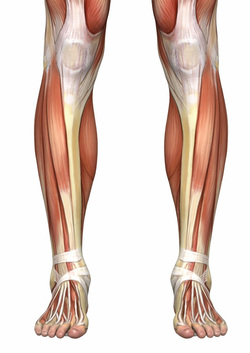
SHIN SPLINTS (compartment syndrome & periostitis)
Periostitis and compartment syndrome are often grouped together under the common term “shin splints”, and is a non-specific phrase that describes pain along the shin with exercise.
Periostitis is inflammation of the periosteum or the membrane that lines the outer surface of bones, and commonly occurs in muscles of the lower leg. More often, female runners are affected and if left untreated, periostitis can lead to stress fractures. Some common causes include overuse due to overtraining, poor technique, running on hard or uneven surfaces and improper footwear.
Compartment syndrome is the result of increased pressure within the compartmental fascia of the lower leg and is more often felt in the front of the leg, with the rear portion of the lower legs also being affected. Causes may include an acute trauma such as a direct knock to the shin or chronic overuse due to overtraining, poor technique or training on hard surfaces.
How do I know I have it?
Excessive pronation or flat feet can be a predisposing factor to getting shin splints. Initially acute inflammation, with severe, persistent pain in both the lower legs may be felt. The skin can feel hot, shiny and tight from the swelling. To start, pain is worse on getting up in the morning and with exercise, and reduces with rest. The chronic pain and inflammation can lead to scar tissue developing in the lower leg muscles, resulting in limited activity.
How can massage or pilates help?
Remedial massage via ice and lymphatic drainage can help to reduce inflammation in the acute phase with heat and other manual techniques applied later to stretch the fascia and reduce muscle tension in the lower leg. Compensating structures in the lower back, buttock and thighs are also addressed. Passive stretching techniques are applied to help increase range of motion through the foot and ankle. Homework of self massage, ice and stretching is normally given to speed up the recovery process.
Pilates can help to maintain strength in the lower legs without bulking up the muscles, non weight bearing exercises with low load are given to lengthen muscles and correct poor movement patterns in the foot/ankle, knee and hip.
In more serious cases of acute compartment syndrome where an increase in pressure can affect nerves and arteries of the lower leg, surgical intervention may be required. We always recommend you speak to your main health care provider for proper assessment.
What can I do to prevent Injury?
Warm up before exercise and rest from activities that cause pain, with a gradual return to activity. Self massage and stretches to the lower leg muscles as well as orthotics if needed, can all help to prevent re-injury.
Periostitis and compartment syndrome are often grouped together under the common term “shin splints”, and is a non-specific phrase that describes pain along the shin with exercise.
Periostitis is inflammation of the periosteum or the membrane that lines the outer surface of bones, and commonly occurs in muscles of the lower leg. More often, female runners are affected and if left untreated, periostitis can lead to stress fractures. Some common causes include overuse due to overtraining, poor technique, running on hard or uneven surfaces and improper footwear.
Compartment syndrome is the result of increased pressure within the compartmental fascia of the lower leg and is more often felt in the front of the leg, with the rear portion of the lower legs also being affected. Causes may include an acute trauma such as a direct knock to the shin or chronic overuse due to overtraining, poor technique or training on hard surfaces.
How do I know I have it?
Excessive pronation or flat feet can be a predisposing factor to getting shin splints. Initially acute inflammation, with severe, persistent pain in both the lower legs may be felt. The skin can feel hot, shiny and tight from the swelling. To start, pain is worse on getting up in the morning and with exercise, and reduces with rest. The chronic pain and inflammation can lead to scar tissue developing in the lower leg muscles, resulting in limited activity.
How can massage or pilates help?
Remedial massage via ice and lymphatic drainage can help to reduce inflammation in the acute phase with heat and other manual techniques applied later to stretch the fascia and reduce muscle tension in the lower leg. Compensating structures in the lower back, buttock and thighs are also addressed. Passive stretching techniques are applied to help increase range of motion through the foot and ankle. Homework of self massage, ice and stretching is normally given to speed up the recovery process.
Pilates can help to maintain strength in the lower legs without bulking up the muscles, non weight bearing exercises with low load are given to lengthen muscles and correct poor movement patterns in the foot/ankle, knee and hip.
In more serious cases of acute compartment syndrome where an increase in pressure can affect nerves and arteries of the lower leg, surgical intervention may be required. We always recommend you speak to your main health care provider for proper assessment.
What can I do to prevent Injury?
Warm up before exercise and rest from activities that cause pain, with a gradual return to activity. Self massage and stretches to the lower leg muscles as well as orthotics if needed, can all help to prevent re-injury.
